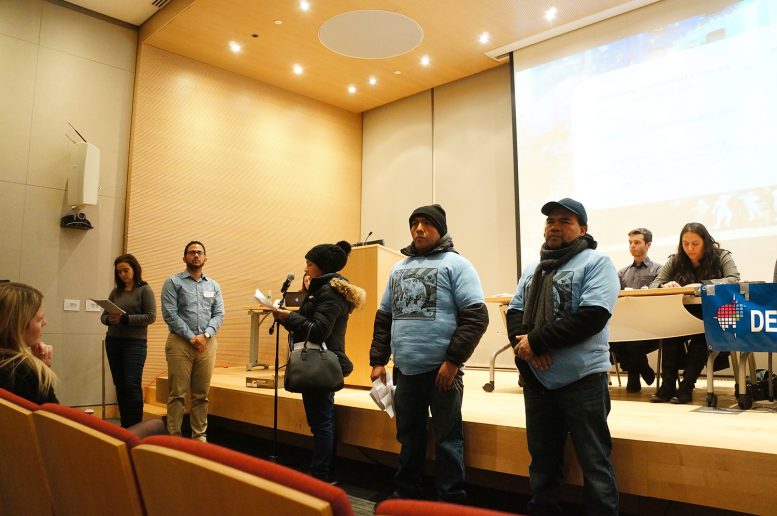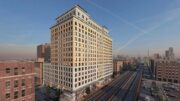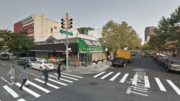Even after City Council Speaker Melissa Mark-Viverito organized two years of community meetings on the future of East Harlem, tenants and activists are lining up to protest the city’s proposed rezoning of 95 blocks in the neighborhood.
Planners unveiled the dramatic new zoning to a relatively small audience during a community board meeting in October. Last Thursday, the Department of City Planning hosted a public scoping meeting at Hunter College’s Silberman School of Social Work. Neighbors, community groups, union members, and even Mark-Viverito herself braved a frigid evening to offer mixed reviews of the plan.
The new land use policies would affect an area stretching from East 104th to East 132nd streets and from Fifth to Second avenues. The most dramatic changes would boost density along Second, Third, and Park avenues. The mayor’s new Mandatory Inclusionary Housing policy would be mapped along the blocks with the densest zoning. It requires builders to set aside at least a quarter of units in a new buildings as affordable housing. Some avenue blocks could get towers as tall as 30 or 35 stories, but new construction on Lexington Avenue will be capped at 11 stories.
During their presentation at the beginning of the meeting, planners noted that they had made a mistake in predicting that 500 tenants would be displaced by the rezoning. DCP only conducts a detailed analysis on displacement numbers when it believes at least 500 tenants will be driven out, and now, it believes East Harlem no longer meets that threshold. None of the other rezonings begun by the de Blasio administration met that 500-tenant minimum either.
Mark-Viverito and a group of neighborhood organizations released the East Harlem Neighborhood Plan (EHNP) in February 2016, and DCP claims it modeled the city’s rezoning plan on the one produced by local groups. But several members of the steering committee that helped craft the EHNP called on the city to require higher percentages of affordable housing, with particular emphasis on lower income families, than Mandatory Inclusionary Housing demands from developers.
Several activists from Community Voices Heard (CVH) stood up to demand that the new zoning should force developers to rent 30 percent of their units at below-market rates to families who make 30 percent of the Area Median Income, which is $23,310 for a three-person household. On publicly-owned sites, developers should be renting 40 percent of their new units to families who make that much, said CVH.
“My adult daughter is homeless and doubled up with my other daughter,” explained local tenant and CVH member Maria Pacheco. “She makes less than 30 percent AMI because of her disability. The story of not being able to find affordable housing has affected many of my family and friends… The MIH program won’t benefit 50 percent of the people that live here.”
The median household income in East Harlem is $26,000, according to 2014 census data. Nearly a third of residents there live below the federal poverty line, which was $19,970 for a family of three in 2014. (The number has since risen slightly higher, to an annual income of $20,160.)
“The insulting aspect of this scenario is that the long process of community visioning is not being honored as it should,” remarked CVH member Pearl Barkley, who concluded that the city’s rezoning would spark “ethnic cleansing” and “class warfare.”
Jameson Mitchell from Civitas presented the East Harlem Neighborhood plan steering committee’s response to DCP’s plan. The proposed R10 and C4-6 districts on Third and Park avenues were too dense, he argued, and R9 zoning would be more appropriate.
“The steering committee won’t consider greater density absent other commitments and a clear preservation strategy as well as additional resources to be made available for more and deeper levels of affordability on East Harlem’s publicly-owned sites,” Mitchell added.
The city should also consider expanding the study area and rezoning to the blocks south of 104th Street and east of Second Avenue, he said. Excluding the pricey area on the East Harlem-Upper East Side border would be a “missed opportunity to potentially reach deeper affordability.” The group did support dense, transit-oriented development near the 125th Street Metro-North station and the 116th Street subway stations, as long as builders would have to pay for subway or pedestrian improvements.
Mark-Viverito backed the steering committee’s comments and reiterated her support for the neighborhood plan she helped create. “I encourage City Planning to continue to work with the community to consider the many other needs articulated in the EHNP,” she said, which include, “deeper affordability, investments in human capital, open space, and cultural preservation, among other things.”
Just as officials tried to close the meeting at 8 p.m., roughly 20 Latino tenant activists from the Movement for Justice in El Barrio strolled into the auditorium, wearing sky blue shirts and with small children and infants in tow. After their lead organizer argued with DCP for a few minutes, the planners re-opened the hearing and allowed three of the activists to speak.
“We are the women, men, elderly, girls, boys, that would be most affected by Mayor de Blasio’s luxury housing plan,” Movement for Justice member Ruben Florencio explained in Spanish, through a translator. “We do not want trees or parks in exchange for his luxury housing plan. We don’t want your beautification plan because our barrio is beautiful, and we want to preserve it the way it is… That’s why REBNY supports the mayor’s luxury housing plan. It in no way favors the people of our beloved El Barrio.”
Ultimately, the activists dominated the end of the hearing. They marched out of the building chanting “El Barrio Unido Jamás Será Vencido!” (“El Barrio United Will Never Be Defeated!”)
Subscribe to YIMBY’s daily e-mail
Follow YIMBYgram for real-time photo updates
Like YIMBY on Facebook
Follow YIMBY’s Twitter for the latest in YIMBYnews






Funny how most of these people live in some sort of government subsidized housing are the ones complaining. The system and housing they are rallying against is the exact same same system that clothes and feeds them, since they can’t do it on their own. Don’t bite the hand that feeds you.
It is incredible how easy it is for you to attack those who want to Preserve the affordability of the neighborhood and protect their community from the massive amounts incentives the government gives to Developers to destroy neighborhood and remove people from their community.
Have you seen a rezoning plan for the upper East or West side? And if there were one would you feel the same way about the rich showing up at a public meeting to demand the government not incentives neighbourhood distribution?
You do realize that without an increase in capacity housing prices will continue to rise, thus pushing out existing residents?
There are 24, yes 24 public housing developments in the neighborhood not to mention the scores of people living off of section 8 vouchers. Enough with this crying and complaining about everything. Your sense of entitlement has clouded your judgement. The country is broke and sick and tired of dragging along the bottom 25% of the country.
NYC is full of welfare moochers and their quid-pro-quo politicians
I am just one to receive the situation and follow an event, filter my comment safely for this article.
There are many people crying wolf about developers coming into there neighborhood and taking away what they have. It’s time that these people declare what they are really making. Most of these people that are in affordable housing has been there for generation, it’s handed down to them from there grandparents to there mother and so on. They make more that $23,000. a year, how else can they afford to drive a Mercedes. Have you seen what’s parked in the housing parking lot, and they are complaining. I know a lot of people that don’t deserve these apartment. I think the elderly and vet’s should get first preference and anyone after that should produce a stamped copy of there tax return from the IRS. Then you will see who is really making under $20,000 per year. These people forge there papers and payoff people so they can claim that they are living below the poverty level. Do you see the way they are dressed, if you live below the poverty level you should not have a new Mercedes parked in the housing parking lot nor should you be sporting an out fit that cost more that your grandmother’s social security check. It’s time we give the people who really need the help not the one that’s steeling it for the elderly and vet’s
Do they understand that if there is no rezoning gentrification will happen anyway but without affordable housing?
Very interesting